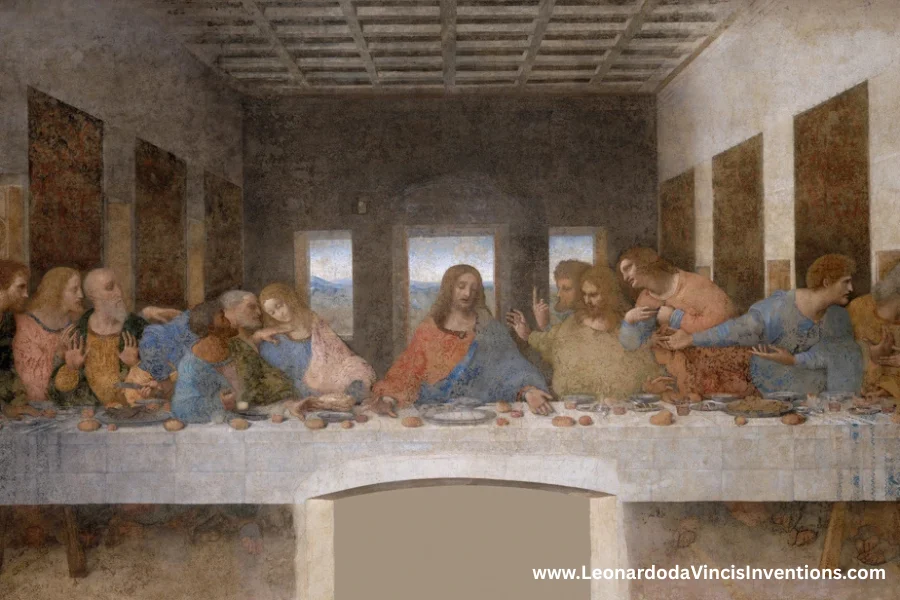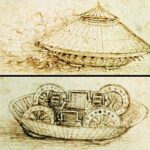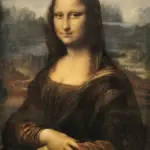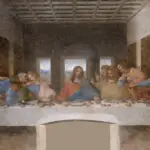
Leonardo da Vinci life span is often discussed when people try to understand how his experiences shaped his art. Many wonder if his life events contributed to the uniqueness of his most famous paintings.
This article delves into the details, allowing you to see how his long and eventful life shaped his creative work.
Leonardo da Vinci’s life—the events he witnessed, the places he traveled, and the challenges he faced—left a mark on his art. He lived from 1452 to 1519, a period marked by significant change and discovery, known as the Renaissance.
His works reflect the growth and ideas of that time. Leonardo’s curious mind led him to study not only painting but also science, engineering, and nature.
This curiosity is evident in pieces like The Mona Lisa and The Last Supper, making his artwork stand out among other artists of his era.
Those interested in his biography can learn more about Leonardo da Vinci’s life and achievements. You can also explore how his scientific discoveries shaped his creative process at BBC Science Focus.
Leonardo da Vinci Life Span: Setting the Stage for Genius
Leonardo da Vinci’s life, which stretched from 1452 to 1519, set the foundation for his work as a painter, inventor, and scientist. Growing up in Renaissance Italy, he absorbed the energy of Florence and Milan.
This environment shaped his achievements in art, engineering, and anatomy.
The Early Years: Birth, Education, and Family in Italy
Leonardo da Vinci was born on April 15, 1452, in Vinci, a small town in Tuscany, Italy. His birth outside of marriage to a local notary and a peasant woman shaped his early experiences, as he did not receive a formal classical education.
He demonstrated a natural talent for drawing and a curious nature from a young age. He moved to Florence with his father, who soon recognized Leonardo’s abilities and arranged an apprenticeship with Andrea del Verrocchio, a respected artist.
This workshop exposed Leonardo to painting, sculpture, and technical drawing. The skills he learned here later influenced his wide-ranging works and innovations as an adult.
Early on, Leonardo experienced encouragement to explore many disciplines. This set him on a path to become a true Renaissance polymath.
Historical Context: Renaissance Florence and Milan
Leonardo’s achievements unfolded during the height of the Renaissance, a period of immense creativity in science and art. Florence was a vibrant cultural center, home to influential families like the Medici, who supported the arts and learning.
In this environment, Leonardo worked on early masterpieces and developed friendships with other artists. By his late twenties, Leonardo moved to Milan and worked under Duke Ludovico Sforza.
Milan’s court valued artists, engineers, and architects, providing them with opportunities for artistic experimentation and engineering projects. Here, he created important works such as The Last Supper and advanced his studies in anatomy, mechanics, and architecture.
These cities played a crucial role in shaping his career. They encouraged his multidisciplinary approach and experiments, which are documented in his notebooks.
Leonardo da Vinci’s Birth and Death Dates: Years of Life (1452–1519)
Leonardo da Vinci was born in 1452 and died in 1519 at age 67 in Amboise, France. This long life span gave him decades to pursue and refine his interests in art and science.
His later years in France were spent under the patronage of King Francis I, where he continued to work on inventions and studies. Throughout his life, Leonardo filled notebooks with detailed sketches, observations, and inventions.
Some of his ideas would not be fully understood until centuries later. His legacy is recognized worldwide for its breadth and lasting impact on art and science.
How Leonardo da Vinci’s Life Span Shaped His Artistic Achievements
Leonardo da Vinci’s life (1452–1519) was shaped by remarkable cultural, scientific, and artistic developments in Italy and across Europe. His experiences in Florence, Milan, and France connected him with powerful patrons and new ideas.
He constantly found innovation in art and science.
Major Works and Masterpieces: Mona Lisa, The Last Supper, Vitruvian Man
Leonardo da Vinci created some of history’s most famous masterpieces during the Italian Renaissance. Early in his career, he painted religious works and portraits in Florence before moving to Milan, where he produced “The Last Supper.”
This mural stands out for its use of perspective and emotional storytelling. His drawing of the “Vitruvian Man” combines science and art, showcasing his interest in anatomy and the proportions of the human body.
Later, he painted the “Mona Lisa,” a portrait valued for its realism and detailed technique. These pieces reflect his technical skill, curiosity, and scientific observations.
Influence of Later Years in France on Leonardo’s Art
During the final years of Leonardo’s life, King Francis I of France invited him to Amboise. Here, Leonardo continued to develop his ideas and supervised important artistic projects, although he produced fewer paintings due to his advancing age and declining health.
He focused more on scientific studies, engineering projects, and anatomy. His notebooks from this time contain detailed sketches and observations that influenced both artists and scientists.
Leonardo’s exposure to the French court expanded his influence beyond Italy. His later years in France, until he died in 1519, significantly contributed to his legacy and the lasting impact of his innovations.
The Role of Patrons: Medici, Sforza, and Supporters
Leonardo da Vinci’s personal and professional life was shaped by key patrons like the Medici family in Florence and Ludovico Sforza in Milan. Early support from the Medici allowed Leonardo to learn from leading thinkers and start his career as a polymath and artist.
Under Sforza, Leonardo worked as a painter, architect, and engineer, receiving major commissions, including “The Last Supper.” Later, Francis I of France supported him in his last years, allowing him to pursue scientific discoveries and inventions.
These patrons influenced the course of his achievements. Their support helped Leonardo leave a lasting mark on Renaissance art and science.
Leonardo da Vinci as a Polymath: Impact of a Long Life
Leonardo da Vinci’s years, from 1452 to 1519, allowed him to explore various fields and make significant contributions. His long life helped him become a key figure in the Italian Renaissance.
He filled his creative career with scientific discoveries, artistic masterpieces, and innovative inventions.
Multidisciplinary Genius: Painter, Inventor, Scientist, Engineer, Architect
Leonardo was a true polymath, known for being a painter, inventor, scientist, engineer, and architect. His accomplishments included works such as the Mona Lisa and The Last Supper, both celebrated for their realistic detail and emotional depth.
He studied anatomy to gain a deeper understanding of the human body for his art. Leonardo also designed machines, from flying devices to war engines, many of which were ahead of their time.
His career in Florence and Milan introduced him to powerful patrons like the Medici and Sforza families. Their support expanded his influence throughout Italy.
Contributions to Art and Science: Innovation and Discoveries
Leonardo’s long life allowed him to experiment with both art and science over many decades. He used oil paint in new ways, developing shading techniques that made his paintings more lifelike.
In science, he studied human anatomy, plants, water, and flight, recording his findings in his famous notebooks. His observations led to important discoveries about the body and nature.
He created sketches for inventions such as helicopters and bicycles that would not be built for centuries to come. Because he lived into his late 60s, he had time to explore new ideas and complete major works.
Leonardo’s Notebooks and Sketches: Documenting Curiosity and Creativity
Leonardo filled thousands of pages with sketches, notes, and diagrams. These notebooks demonstrate his wide-ranging interests, encompassing human figures and engineering designs.
The Vitruvian Man, drawn in the 1490s, is one of his most well-known drawings and highlights the link between art and anatomy. He often wrote in reverse script, making his notes difficult to read.
His drawings reveal step-by-step studies of the world around him. Historians use these notebooks to piece together the life and works of Leonardo da Vinci.
These records show the impact of his curiosity and creativity over his long life span.
Legacy and Influence: Did Leonardo da Vinci Life Span Matter?
Leonardo da Vinci’s life span, from 1452 to 1519, allowed him to work across several Italian cities and explore a wide range of disciplines. His long years gave him the time to shape the fields of painting, science, and engineering.
He left a substantial impact on future generations.
Influence on Future Generations and Cultural Significance
Leonardo da Vinci’s influence reaches far beyond his years in Florence, Milan, and France. As a polymath, he inspired not only artists but also scientists, engineers, and inventors.
His notebooks are filled with sketches and written observations about nature, anatomy, mechanics, and flight. These works, comprising thousands of pages in total, showcased his endless curiosity and meticulous study of the world.
Artists and thinkers from later centuries studied his drawings to learn both technique and method. Today, his legacy lives on in museums, books, and classrooms.
Leonardo’s impact can be seen in new inventions, art styles, and the way people view discovery and learning.
Leonardo da Vinci’s Legacy in the High Renaissance and Beyond
Leonardo da Vinci’s career marked the height of the High Renaissance. His masterpieces, such as the Mona Lisa and The Last Supper, revolutionized how artists approached composition, expression, and perspective.
These works became guides for other painters. Leonardo blended science and art in his approach.
He studied anatomy to give his figures lifelike movement and realistic detail. He set new standards for painting with his innovative use of light and shadow, a technique known as sfumato.
After his death, artists across Europe drew inspiration from Leonardo’s paintings, drawings, and inventions.
Achievements and Accomplishments: Impact on Renaissance Art and Science
Leonardo made significant advances in art, design, and scientific studies. He created careful anatomical drawings and planned machines that would not be built for centuries.
He designed flying machines, bridges, and armored vehicles. His study of the human body, mathematics, and nature helped shape new scientific ideas during the Italian Renaissance.
Patrons like the Medici and Sforza families supported Leonardo. Their support allowed him to work on public projects, private commissions, and ambitious studies that combined art and engineering.
He set an example for mixing creativity with disciplined research.
The Personal and Professional Life of Leonardo da Vinci
Leonardo da Vinci lived during the High Renaissance, a period of innovation and discovery in Italy, spanning his life from 1452 to 1519, which coincided with major cultural changes.
His works continue to shape discussions about creativity and influence in art and science.
Leonardo’s Personal Life: Biography, Drawings, and Scientific Studies
Leonardo da Vinci was born in 1452 in Vinci, a small town near Florence. He grew up as the illegitimate child of a notary and received only a basic education.
His curiosity led him to study anatomy, engineering, and nature. He filled notebooks with detailed drawings and scientific observations.
He explored topics like flight, human anatomy, and machines. Leonardo kept his personal life private, but his writings reveal an endless desire to learn.
His studies bridged art and science. Leonardo provided insights into the human body, plant life, and mechanical devices.
Key Events and Turning Points in Leonardo’s Career
Leonardo began his artistic training as an apprentice to Andrea del Verrocchio in Florence, where he learned both painting and sculpture. He worked in Milan for seventeen years, serving Duke Ludovico Sforza and creating The Last Supper.
After political changes in Milan, Leonardo moved between cities and completed projects for various patrons, including the Medici family. In his later years, he moved to France at the invitation of King Francis I.
He spent the rest of his life there. Leonardo’s inventions, notebooks, and artistic masterpieces showed his unique approach as a painter, engineer, and scientist.
Historical Importance and Context of Leonardo da Vinci’s Life and Works
Leonardo’s multidisciplinary talents helped define the Renaissance spirit of exploration and learning. His achievements, such as painting the Mona Lisa and drawing the Vitruvian Man, set new standards in art and science.
His notebooks reveal innovative designs and discoveries that influenced later inventors and artists. Leonardo’s legacy as a polymath continues to inspire curiosity and creativity today.
Frequently Asked Questions
Leonardo da Vinci lived during the Renaissance and made a lasting mark on art, science, and invention. His personal life, habits, and even his death have been the subject of curiosity and study for centuries.
What caused Da Vinci’s death?
Leonardo da Vinci died on May 2, 1519, at the age of 67. He likely died from a stroke.
Later in life, he suffered paralysis in his right hand, which may have contributed to his health problems.
What was da Vinci’s IQ?
There are no official records of Leonardo da Vinci’s IQ, as the concept of IQ did not exist during his time. Some experts speculate he may have had a high IQ based on his inventions, art, and wide range of talents.
Did Da Vinci have kids?
Leonardo da Vinci never married and had no known children. He dedicated most of his life to his work and studies.
What happened to Leonardo da Vinci when he was 15?
At age 15, Leonardo began an apprenticeship with Andrea del Verrocchio in Florence. This introduced him to painting, sculpture, and mechanical arts.
Where is Mona Lisa buried?
The Mona Lisa is a famous painting created by Leonardo da Vinci. The woman believed to have posed for it, Lisa Gherardini, is thought to be buried in Florence, Italy.
The painting itself is displayed in the Louvre Museum in Paris.
What did da Vinci suffer from?
In his later years, da Vinci suffered from paralysis in his right hand. Some reports suggest he also dealt with periods of depression.
Despite his physical limitations, he continued to work with his left hand.
What were da Vinci’s last words?
Leonardo da Vinci reportedly expressed regret that he had not accomplished enough in his life, despite his many achievements. His last words reflected his high expectations for himself.
How old is the Mona Lisa?
Leonardo da Vinci painted the Mona Lisa between 1503 and 1506, more than 500 years ago. The Mona Lisa is over five centuries old today.
Was da Vinci a vegetarian?
Leonardo da Vinci is believed to have been a vegetarian for much of his life. He loved animals and wrote about the ethics of eating meat, although not all historians agree on how strictly he adhered to this stance.
Did Leonardo da Vinci ever marry?
Leonardo da Vinci never married during his life span.
There is no historical record of romantic relationships or a spouse.
He focused mainly on his art, inventions, and studies.

 I’m Leonardo Bianchi, the mind behind Leonardo da Vinci's Inventions. Thanks for visiting.
I’m Leonardo Bianchi, the mind behind Leonardo da Vinci's Inventions. Thanks for visiting. 


